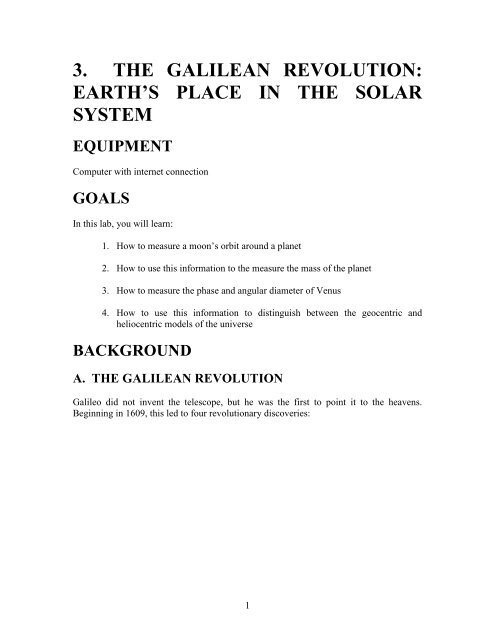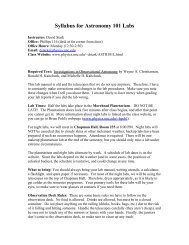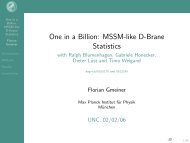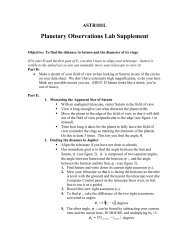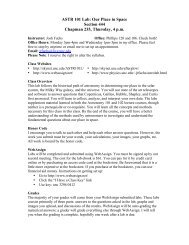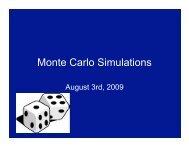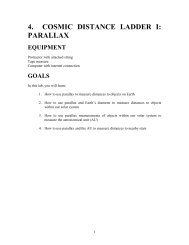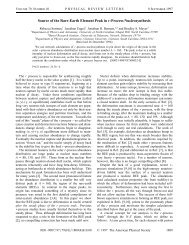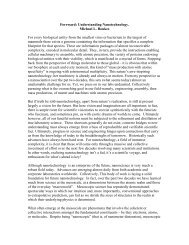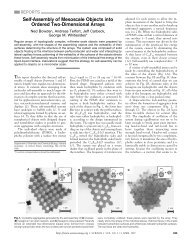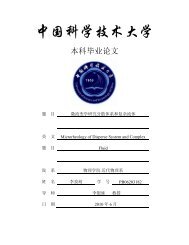3. THE GALILEAN REVOLUTION: EARTH'S PLACE IN THE SOLAR ...
3. THE GALILEAN REVOLUTION: EARTH'S PLACE IN THE SOLAR ...
3. THE GALILEAN REVOLUTION: EARTH'S PLACE IN THE SOLAR ...
You also want an ePaper? Increase the reach of your titles
YUMPU automatically turns print PDFs into web optimized ePapers that Google loves.
<strong>3.</strong> <strong>THE</strong> <strong>GALILEAN</strong> <strong>REVOLUTION</strong>:<br />
EARTH’S <strong>PLACE</strong> <strong>IN</strong> <strong>THE</strong> <strong>SOLAR</strong><br />
SYSTEM<br />
EQUIPMENT<br />
Computer with internet connection<br />
GOALS<br />
In this lab, you will learn:<br />
1. How to measure a moon’s orbit around a planet<br />
2. How to use this information to the measure the mass of the planet<br />
<strong>3.</strong> How to measure the phase and angular diameter of Venus<br />
4. How to use this information to distinguish between the geocentric and<br />
heliocentric models of the universe<br />
BACKGROUND<br />
A. <strong>THE</strong> <strong>GALILEAN</strong> <strong>REVOLUTION</strong><br />
Galileo did not invent the telescope, but he was the first to point it to the heavens.<br />
Beginning in 1609, this led to four revolutionary discoveries:<br />
1
1. He discovered craters and mountains on the moon:<br />
2. He discovered spots on the sun:<br />
Both of these were revolutionary in that the Catholic church had long ago adopted the<br />
Aristotelian idea that the moon and sun were “perfect” objects – spherical, perfectly<br />
smooth, and in the case of the sun, unblemished.<br />
2
<strong>3.</strong> He discovered four moons orbiting Jupiter:<br />
.<br />
This was revolutionary in that it contradicted the geocentric model of the universe – the<br />
idea that Earth is at the center of the universe and everything orbits it. The geocentric<br />
model had also been long ago adopted as truth by the Catholic church.<br />
3
4. He discovered the phases of Venus:<br />
Although lesser known than the discovery of Jupiter’s moons, the discovery of Venus’s<br />
phases is more significant, in that it not only contradicted the geocentric model of the<br />
universe, it confirmed a prediction of the heliocentric model of the universe – the idea<br />
that the sun, not Earth, is at the center.<br />
4
In Aristotle’s (and later Ptolemy’s) geocentric model of the universe, Venus rides on a<br />
circle called an epicycle and the center of Venus’s epicycle rides on a circle called a<br />
deferent around Earth:<br />
5
The center of Venus’s epicycle is always on a line between Earth and the sun.<br />
Consequently, Venus never wanders too far from the sun in the sky, which is what is<br />
observed:<br />
The geocentric model of the universe makes specific predications about Venus’s phases:<br />
(1) Venus’s phase is new or very close to new when it is closest to Earth and<br />
consequently appears largest; (2) It transitions to crescent as it recedes from Earth and<br />
consequently appears smaller; (3) It transitions to new or very close to new again when it<br />
is farthest from Earth and consequently appears smallest; (4) It transitions to crescent<br />
again when it is approaching Earth and consequently appears larger; and (5) It transitions<br />
to new or very close to new again when it is closest to Earth and consequently appears<br />
largest.<br />
These phase and angular diameter transitions correspond to a curve in the following plot.<br />
The curve is thick because different versions of the geocentric model of the universe<br />
make slightly different predictions:<br />
6
The heliocentric model of the universe makes very different predications about Venus’s<br />
phases: (1) Venus’s phase is new or very close to new when it is closest to Earth and<br />
consequently appears largest; (2) It transitions to crescent and then quarter and then<br />
gibbous as it recedes from Earth and consequently appears smaller; (3) It transitions to<br />
full or very close to full when it is farthest from Earth and consequently appears smallest;<br />
(4) It transitions to gibbous and then quarter and then crescent again when it is<br />
approaching Earth and consequently appears larger; and (5) It transitions to new or very<br />
close to new again when it is closest to Earth and consequently appears largest:<br />
7
Here’s a video of Venus in the geocentric model of the universe:<br />
http://www.youtube.com/watch?v=OlnlbZHP-jk<br />
It plays fast. Play it enough times to see all of the phase and angular diameter transitions.<br />
Here’s a video of Venus in the heliocentric model of the universe:<br />
http://www.youtube.com/watch?v=0Z_v7Tag4fg<br />
Again, play it enough times to see all of the phase and angular diameter transitions.<br />
If part C of the procedure, you will measure Venus’s phase and angular diameter at<br />
different times and then use this information to distinguish between the geocentric and<br />
heliocentric models of the universe.<br />
8
B. ORBITS<br />
Kepler showed that planets orbiting the sun and moons orbiting planets do not travel on<br />
circles, but on ellipses, with the central body at one of the two foci:<br />
The long axis of an ellipse is called the major axis. Half of the major axis is called the<br />
semi-major axis, which is usually denoted a.<br />
9
Kepler also showed that the time that it takes for a planet to orbit the sun or for a moon to<br />
orbit a planet – the orbital period, which is usually denoted P – is related to the semimajor<br />
axis in the following way:<br />
P 2 = constant × a 3<br />
where the value of the constant depends on the central body: All planets orbiting the sun<br />
have the same constant. All moons orbiting Jupiter share a different constant. The moon<br />
orbiting Earth has yet another constant.<br />
Newton showed that the value of the constant depends on the mass of the central body:<br />
P 2 = (4π 2 / M) × a 3<br />
(This assumes that the mass of the central body is significantly greater than the mass of<br />
the orbiting body.)<br />
Now, consider the case of Earth orbiting the sun. Then P = 1 year, M = 1 solar mass, and<br />
a = 1 AU (astronomical unit = 1 sun-Earth distance). Hence:<br />
(1 year) 2 = (4π 2 / 1 solar mass) × (1 AU) 3<br />
Dividing this equation into the previous equation yields:<br />
(P / 1 year) 2 = (1 solar mass / M) × (a / 1 AU) 3<br />
Solving for the mass of the central body yields:<br />
M = [(a / 1 AU) 3 / (P / 1 year) 2 ] solar masses.<br />
Hence, by measuring the semi-major axis of a moon’s orbit around a planet in AU and its<br />
orbital period in years, you can measure the mass of the planet in solar masses. In parts<br />
A and B of the procedure, you will measure the orbit of a moon around one of the four<br />
Jovian planets and then use this information to measure the mass of that planet.<br />
10
PROCEDURE<br />
A. MONITOR A PLANETARY SYSTEM WITH SKYNET<br />
In the following tutorial, you will learn how to monitor an object over an extended period<br />
of time:<br />
http://skynet.unc.edu/ASTR101L/videos/monitor/<br />
Use Skynet to monitor an observable Jovian planetary system every clear night for<br />
two weeks. Select Jupiter, Saturn, Uranus, or Neptune. Similar numbers of<br />
students should monitor each system.<br />
Remember to change “If interrupted…” to “Continue on next free telescope” just in case<br />
the telescope that begins your observations goes offline during the next two weeks.<br />
11
Confirm that the planetary system that you selected is indeed observable from CTIO this<br />
time of year:<br />
If it is not, select a different planetary system.<br />
Select as many of PROMPT-1, PROMPT-3, PROMPT-4, and PROMPT-5 as you can,<br />
but do not select PROMPT-2 since we take it offline every two weeks.<br />
Select filters and request exposure durations that will allow you to detect as many moons<br />
as possible without overly saturating the planet:<br />
System Filter Exposure Duration (seconds)*<br />
Jupiter V 0.03<br />
Saturn Open 0.03<br />
Uranus Open 1<br />
Neptune Open 1<br />
* For PROMPT. Other telescopes might require longer exposures.<br />
12
Request two exposures (just in case one disappoints) and below this request “Repeat<br />
these exposures 14 times with 1 day between groups of exposures”:<br />
13
EXERCISE 1: MAKE A MOVIE OF <strong>THE</strong> MOONS ORBIT<strong>IN</strong>G <strong>THE</strong><br />
PLANET<br />
In the following tutorial, you will learn how to select and align images, which must be<br />
done before they can be made into a move:<br />
http://skynet.unc.edu/ASTR101L/videos/align/<br />
Select and align your images. Remember:<br />
1. If the planet is in the same general area in each of your images, feel free to change<br />
“Cropping Method” to “Overlay Only”. Otherwise, use “Maximize”.<br />
2. Since you will align by clicking on the planet, change “Stellar Method (PSF)” to<br />
“Planetary Method (Disk)”.<br />
<strong>3.</strong> Select, or create and select, a target directory in your “Workspace”, where your<br />
selected and aligned images can be saved.<br />
4. For each image, either select and align it by clicking on the planet or reject it by<br />
clicking the “Reject” button.<br />
14
In the following tutorial, you will learn how to turn selected and aligned images into a<br />
movie:<br />
http://skynet.unc.edu/ASTR101L/videos/movie/<br />
Turn your selected and aligned images into a movie. Remember:<br />
1. If you want to see the moons orbit the planet, stop the movie. Select “ZScale” in the<br />
“Histogram” window and “Equalize Histogram” in the “Make Movie” window. Then<br />
play.<br />
2. If you want to see the planet rotate, stop the movie. Select “MinMax” in the<br />
“Histogram” window and “Equalize Histogram” in the “Make Movie” window. (This is<br />
more impressive for Jupiter than it is for Saturn, Uranus, and Neptune).<br />
Repeat #1 to see the moons orbit the planet and click “Download Movie”. Include<br />
this movie in your lab report.<br />
15
B. ORBIT AND MASS DETERM<strong>IN</strong>ATION<br />
EXERCISE 2: MEASURE <strong>THE</strong> ANGULAR AND PHYSICAL<br />
DIAMETERS OF <strong>THE</strong> PLANET<br />
Identify the sharpest looking of your images. Open it in Afterglow and zoom in until the<br />
planet fills your window. Select the histogram window and select minmax.<br />
Measure the angular diameter of the planet to the nearest 0.1 arcseconds.<br />
θ = ____________________<br />
Note: This value should be larger than the true value due to atmospheric blurring, but<br />
this effect will cancel out and not affect your mass measurement.<br />
Use Stellarium to find the distance to the planet when Skynet took your image, in AU:<br />
distance = ____________________<br />
Note: In Lab #4, you will learn how to measure distances to solar system objects<br />
directly using parallax, instead of having to look them up in Stellarium. But this will<br />
do for now.<br />
16
Once the angular diameter of the planet and the distance to the planet are known, the<br />
physical diameter of the planet can be determined:<br />
The physical diameter of the planet as a fraction of the circumference of the big circle is<br />
the same as the angular diameter of the planet as a fraction of 360°:<br />
diameter / circumference = θ / 360°<br />
Since circumference = 2π times radius and the radius of the big circle is the distance to<br />
the planet:<br />
diameter / (2π × distance) = θ / 360°<br />
Solving for the physical diameter of the planet yields:<br />
diameter = 2π × distance × (θ / 360°)<br />
Note: Remember to convert θ to degrees before using this equation!<br />
diameter = ____________________<br />
Note: Since in AU, this should be a very small number.<br />
Note: This value should be larger than the true value since θ should be larger than its<br />
true value due to atmospheric blurring, but these effects will cancel out and not affect<br />
your final mass measurement.<br />
17
EXERCISE 3: MEASURE <strong>THE</strong> ORBIT OF A MOON<br />
Next you are going to measure the orbit of one of your planet’s moons:<br />
If your planet is Jupiter, you will measure the orbit of Ganymede.<br />
If your planet is Saturn, you will measure the orbit of Titan.<br />
If your planet is Uranus, you will measure the orbit of Oberon.<br />
If your planet is Neptune, you will measure the orbit of Triton.<br />
For each of your successful observations:<br />
1. Select the better of the two images.<br />
2. For that image, select the information window and record the system (not universal)<br />
date and time that the image was taken in Data Table 1. Also record the Julian date that<br />
the image was taken in Data Table 1, to the nearest 0.1 days.<br />
<strong>3.</strong> Adjust the max value and zoom in/out until you can easily see the moons. Use<br />
Stellarium to identify which one is Ganymede, Titan, Oberon, or Triton. (If the moon is<br />
too close to the planet to see, or so far from the planet that it is off the image, skip this<br />
observation.)<br />
4. Measure the angular distance between the center of the planet and the center of the<br />
moon. Record it to the nearest 0.1 arcseconds in Data Table 1.<br />
18
EXERCISE 4: MEASURE <strong>THE</strong> MASS OF <strong>THE</strong> PLANET<br />
Go to:<br />
http://skynet.unc.edu/ASTR101L/graph<br />
and select “Moon”. In the following tutorial, you will learn how to graph your data and<br />
measure an orbit’s semi-major axis in arcseconds and period in days.<br />
http://skynet.unc.edu/ASTR101L/videos/graph-moon/<br />
Make a graph of angular distance vs. Julian date and adjust a, P, and the phase and<br />
tilt of the orbit until the curve best matches your data.<br />
The maximum angular distance between the moon and the planet is the semi-major axis<br />
of the moon’s orbit, in arcseconds:<br />
a in arcseconds = ____________________<br />
The time between peaks is the time it takes for the moon to move from one side of the<br />
planet to the other. This is half of the moon’s orbital period. The time between two<br />
peaks is the moon’s orbital period, in days:<br />
P in days = ____________________<br />
P in years = ____________________<br />
19
Next, use your measurements of the planet’s angular diameter in arcseconds and physical<br />
diameter in AU from Exercise 2 to convert your measurement of the moon’s orbital semimajor<br />
axis from arcseconds to AU:<br />
a in AU = (a in arcseconds) × (diameter in AU / θ in arcseconds)<br />
a in AU = ____________________<br />
Note: Since in AU, this should be a very small number.<br />
By Newton’s form of Kepler’s Third Law, the mass of the planet must then be:<br />
M = [(a / 1 AU) 3 / (P / 1 year) 2 ] solar masses<br />
M = ____________________<br />
Finally, convert the planet’s mass to Earth masses: 1 solar mass = 333,000 Earth masses.<br />
M = ____________________<br />
Google the true mass of your planet in Earth masses and compute your percent<br />
error. Discuss sources of error.<br />
In your lab report, include Data Table 1 and your graph of angular distance vs.<br />
Julian date.<br />
20
C. VENUSIAN PHASES<br />
Venus’s angular diameter and illuminated angular distance are defined as follows:<br />
Use Afterglow to measure the angular diameter and illuminated angular distance of<br />
Venus (1) in your image from Lab #1, if you got one of Venus, and (2) in archival<br />
images (in Afterglow, go to “File”, “Open Image(s)”, “Sample Images”, “Astro 101<br />
lab”, “Lab 3 – Galilean Revolution”, “Venus”). Record these to the nearest 0.1<br />
arcseconds in Data Table 2.<br />
Note: For each image, zoom in until Venus fills your window. Select the histogram<br />
window and select minmax.<br />
Venus’s phase is given by:<br />
phase = illuminated angular distance / angular diameter<br />
21
Compute Venus’s phase for each image and record this to two decimal places in<br />
Data Table 2.<br />
Go to:<br />
http://skynet.unc.edu/ASTR101L/graph<br />
and select “Venus”.<br />
Make a graph of Venus’s phase vs. angular diameter.<br />
Are your observations more consistent with the geocentric model of the universe or<br />
the heliocentric model of the universe? Discuss sources of error.<br />
22
DATA TABLE 1: PLANETARY MOONS<br />
Planet: ____________________<br />
Moon: ____________________<br />
System Date System Time Julian Date<br />
(days)<br />
Angular<br />
Separation<br />
(arcseconds)<br />
23
DATA TABLE 2: VENUSIAN PHASES<br />
Image<br />
Angular Diameter<br />
(arcseconds)<br />
Illuminated Angular<br />
Distance (arcseconds)<br />
Phase<br />
1<br />
2<br />
3<br />
4<br />
5<br />
6<br />
7<br />
24


